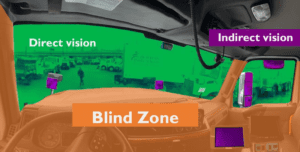Who is a member?
Our members are the local governments of Massachusetts and their elected and appointed leadership.

The state has published a study measuring the “direct vision” of truck drivers.
The Massachusetts Department of Transportation has published a study that measures the “direct vision” available to drivers of state trucks, as well as those of 10 municipalities.
The Commonwealth of Massachusetts Direct Vision Study found that drivers of heavy-duty vehicles cannot easily see people around them. Drivers in 50% of the heavy-duty vehicles in the study could not see a child directly in front of the vehicle. Side visibility was also obstructed; drivers in 90% of heavy-duty trucks studied could not see a child in an adjacent bike lane, and 80% could not see an adult in a bike lane.
The study included vehicles from MassDOT contractor fleets and fleet samples from 10 municipalities that have had a serious injury or fatality resulting from an accident involving a large truck in the past 10 years. Municipalities that participated in the study were Cambridge, Everett, Falmouth, Gardner, Lynn, Medford, Needham, Somerville, Waltham and Westfield.
Direct vision is the ability of drivers to see firsthand outside their vehicle without the aid of an indirect vision device (such as mirrors and cameras), enabling eye contact between the driver and a vulnerable road user near the vehicle. MassDOT reports that drivers’ perception and reaction are 50% better with direct vision than with indirect vision.
The study sought to learn the range of direct vision performance in the MassDOT fleet, vehicles of contractors, and vehicles of partnering municipalities, and what countermeasures would be most appropriate to increase direct vision in various vehicles.
Sixty vehicles were studied, and comparisons among different years, makes and models within vehicle classes were also considered. Of the heavy-duty vehicles measured, the cab-forward style tended to have higher forward visibility.
On average, light-duty vehicles had the highest visibility in the fleets studied. Medium-duty vehicles had lower visibility, and heavy-duty vehicles had the lowest visibility.
The report recommends downsizing vehicles whenever possible.
The study was called for by a 2022 traffic safety law and was conducted in collaboration with the Volpe National Transportation Systems Center. Additional information is available on the study website.